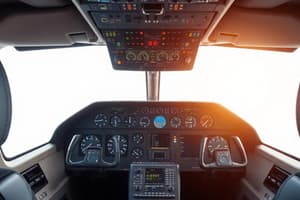Podcast
Questions and Answers
What is the force that moves an aircraft through the air?
What is the force that moves an aircraft through the air?
- Thrust (correct)
- Lift
- Drag
- Weight
What is the primary purpose of flaps on an aircraft?
What is the primary purpose of flaps on an aircraft?
- To shorten the takeoff distance only
- To decrease the angle of descent for landing
- To increase the stall speed
- To reduce the speed at which an aircraft can be safely flown (correct)
What is the result of accelerating a mass of gas rearward in an aircraft engine?
What is the result of accelerating a mass of gas rearward in an aircraft engine?
- The engine is damaged
- Thrust is generated in the opposite direction (correct)
- The aircraft is propelled backward
- The engine is cooled
What is the effect of deploying slats on an aircraft?
What is the effect of deploying slats on an aircraft?
What is a common use of slats on aircraft?
What is a common use of slats on aircraft?
What is the shape of a propeller blade?
What is the shape of a propeller blade?
What is the purpose of slats when landing or performing maneuvers?
What is the purpose of slats when landing or performing maneuvers?
What is the purpose of thrust in an aircraft?
What is the purpose of thrust in an aircraft?
What is the primary factor that determines the stalling speed of an aircraft?
What is the primary factor that determines the stalling speed of an aircraft?
What occurs when the critical angle of attack is exceeded?
What occurs when the critical angle of attack is exceeded?
What is the variable that represents the air density in the general airplane lift equation?
What is the variable that represents the air density in the general airplane lift equation?
What is the typical range of the critical angle of attack for most subsonic airfoils?
What is the typical range of the critical angle of attack for most subsonic airfoils?
What determines the magnitude of thrust?
What determines the magnitude of thrust?
What is the purpose of a stick shaker in an aircraft?
What is the purpose of a stick shaker in an aircraft?
What is the effect of increasing the platform area (S) in the general airplane lift equation?
What is the effect of increasing the platform area (S) in the general airplane lift equation?
What is the result of the propeller accelerating a large mass of air rearwards?
What is the result of the propeller accelerating a large mass of air rearwards?
What is the purpose of flaps in normal flight?
What is the purpose of flaps in normal flight?
What happens to the lift coefficient as the angle of attack increases beyond the critical angle?
What happens to the lift coefficient as the angle of attack increases beyond the critical angle?
What happens to an aircraft's angle of attack as it slows down in steady, unaccelerated flight?
What happens to an aircraft's angle of attack as it slows down in steady, unaccelerated flight?
What is the reaction force described by Newton's second and third laws?
What is the reaction force described by Newton's second and third laws?
What is the primary cause of a stall in fixed-wing flight?
What is the primary cause of a stall in fixed-wing flight?
What is the difference between automatic and fixed slats?
What is the difference between automatic and fixed slats?
What happens when an aircraft's angle of attack reaches the critical stall angle?
What happens when an aircraft's angle of attack reaches the critical stall angle?
What is the effect of deploying flaps on an aircraft's drag?
What is the effect of deploying flaps on an aircraft's drag?
What is the effect of flow separation on the wing's ability to create lift?
What is the effect of flow separation on the wing's ability to create lift?
What is the primary function of a propeller in an aircraft?
What is the primary function of a propeller in an aircraft?
What is a characteristic of a stall in an unpowered glider aircraft?
What is a characteristic of a stall in an unpowered glider aircraft?
What is the primary factor that determines the critical angle of attack?
What is the primary factor that determines the critical angle of attack?
What is the correlation between airspeed and stalling speed?
What is the correlation between airspeed and stalling speed?
What happens to the lift of an aircraft as it slows down in steady, unaccelerated flight?
What happens to the lift of an aircraft as it slows down in steady, unaccelerated flight?
Flashcards are hidden until you start studying
Study Notes
FLAP & SLATS
- Flaps are hinged surfaces mounted on the trailing edges of an aircraft's wings to reduce the speed at which an aircraft can be safely flown and increase the angle of descent for landing.
- Flaps shorten takeoff and landing distances by lowering the stall speed and increasing drag.
- Slats are aerodynamic surfaces on the leading edge of an aircraft's wings, allowing the wing to operate at a higher angle of attack, producing a higher coefficient of lift, and enabling the aircraft to fly at slower speeds or take off and land in shorter distances.
LIFT EQUATION
- The general airplane lift equation is: L = (1/2) × ρ × V^2 × S × CL
- Increasing the area (S) and lift coefficient (CL) can generate lift at a lower airspeed (V).
SLATS
- Types of Slats:
- Automatic: lies flush with the wing leading edge until reduced aerodynamic forces allow it to extend.
- Fixed: permanently extended, used on specialist low-speed aircraft or when simplicity takes precedence over speed.
- Powered: extension can be controlled by the pilot, commonly used on airliners.
STALL
- A stall is a reduction in lift coefficient generated by a foil as the angle of attack increases beyond a critical point.
- The critical angle of attack is typically around 15 degrees, but can vary depending on the fluid, foil, and Reynolds number.
- Stalling occurs when the wing's ability to create lift is hindered by separated flow, resulting in decreased lift and increased drag.
THRUST
- Thrust is a reaction force described by Newton's second and third laws, generated by expelling or accelerating mass in one direction.
- Thrust is used to overcome the drag of an aircraft, generated by the engines through a propulsion system.
- The propulsion system must be in physical contact with a working fluid to produce thrust, which is often generated through the reaction of accelerating a mass of gas.
PROPELLER
- The propeller blade is an aerofoil, with definitions for chord, camber, thickness/chord ratio, and aspect ratio similar to those for the wing.
- The propeller accelerates a large mass of air rearwards, propelling the aircraft forward.
Studying That Suits You
Use AI to generate personalized quizzes and flashcards to suit your learning preferences.




